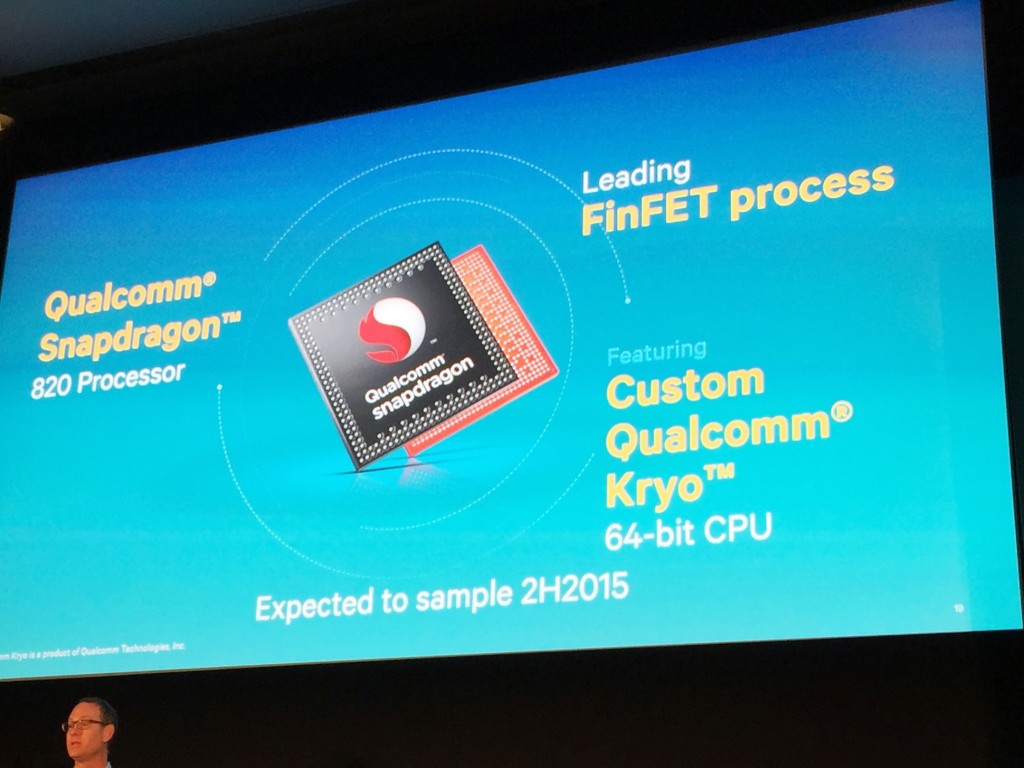 Snapdragon 820 Announcement at MWC 2015 (Credit: Patrick Moorhead, Moor Insights & Strategy)
Snapdragon 820 Announcement at MWC 2015 (Credit: Patrick Moorhead, Moor Insights & Strategy)
At the annual professional graphics conference, SIGGRAPH 2015,
Qualcomm today joined many companies that disclosed their latest graphics technologies. Qualcomm took this opportunity to show those in the graphics industry what kind of a user experience their upcoming
820 SoC is capable of delivering in such a small package. The new Qualcomm
Snapdragon 820, announced at
Mobile World Congress earlier this year, has a multitude of new graphical and video capabilities, with the core of them being in the SoC’s new Adreno 530 GPU, which promises massive improvements over the previous generation in more than one way. While we haven’t see the new mobile smartphone graphics silicon from
ARM Holdings which powers
Samsung Electronics Galaxy S6 or Imagination Technologies Group Plc which powers
Apple smartphones, we can say that the new Adreno 530 at launch could be the most feature-rich and highest performance graphics silicon in a smartphone.
More performance, less power
The Qualcomm Snapdragon 820’s new GPU, the Adreno 530, brings huge performance improvements at significantly less power, making vast improvements in overall graphical capabilities of their 820 SoC. Qualcomm is stating that the Snapdragon 820 will deliver 40% higher average performance in industry-leading benchmarks than the previous generation Adreno 430.
This should make it the fastest smartphone SoC in the world for graphics, until we see what Apple has to offer this fall.
In most benchmarks, the Snapdragon 430 already handily beats almost every smartphone SoC. While some of the latest Snapdragon 810 phones are much faster than our “control” phone, the LG G Flex 2, even using the G Flex 2 as a control for Adreno 430 performance the Snapdragon 820 with the Adreno 530 theoretically beats the Samsung Electronics Exynos 7420 with ARM Holdings Mali graphics by up to 50% in some benchmarks. In other benchmarks, the Qualcomm Snapdragon 820 is faster by single digit margins, but that is purely conjecture, as is our 50% figure because we won’t really know until we benchmark it ourselves.
However, the reality is that the
Snapdragon 820 and Adreno 530 GPU will be available in the first half of 2016 while the Exynos 7420 is available now. By that time, we could actually see a new SoC from Samsung Electronics, but it would be hard to believe that they could improve their performance by 50% without a process node shrink, which won’t happen because they are already on 14nm. The Snapdragon 820 would put Qualcomm’s process technology at the same level as Samsung’s and make comparing the two companies’ chips side by side even easier and fairer. It would also make Samsung Electronics ability to one-up Qualcomm more difficult, however, they could implement ARM Holdings newest 2016 GPU and CPU IP for 14nm and possibly give themselves a fighting chance.
All of this performance also comes with a 40% power reduction, which is absolutely huge and likely thanks to the process node shrink from 20nm to 14nm as well as some compression features as well. What this huge power reduction means is that there’s plenty of power left for the rest of the SoC and even more importantly, the thermals. With the Qualcomm Snapdragon 810, thermals seemed to initially be more of a challenge and with the new Snapdragon 820 with the Kryo CPU cores and Adreno 530 thermals should be a problem of the past. The power efficiency also could mean that we could see Qualcomm giving more power and performance to other parts of the SoC, like the DSP (digital signal processor), ISP (image signal processor) and DPU (display processing unit).
While we don’t know what the overall SoC power consumption reduction is quite yet, with improvements like this on the GPU side of things it seems promising that we could see much better battery life in addition to more performance with the Snapdragon 820. Higher performance and longer battery life are two key points that need to be accounted for when looking to improve the overall user experience of a smartphone. After all, those are the first two things people think about when it comes to picking a phone, how fast it feels and how long it’ll last.
More features, future ready
In addition to more performance and power, the Adreno 530 also brings a lot of improvements to how it handles current and future graphics APIs. It will support Khronos Group’s OpenCL 2.0 fully, which means implementing GPU compute on an Adreno 530 should be easier for mere mortals compared to the past. The Adreno 530 also comes with support for Khronos Group’s OpenGL ES 3.1, Google’s Renderscript and Khronos Group’s Vulkan, all of which are expected to be the standard graphics APIs for mobile now and into the future. Qualcomm is saying the 520 will also have overall improved GPU compute capabilities ranging from 20% to 150% depending on the workload. GPGPU performance is incredibly important for tasks like computer vision and computational photography, both of which are getting more and more traction in the mobile world. Supporting all of these APIs now and into the future also gives developers the ability to create more powerful and intuitive applications that properly utilize all of the aspects of the
Snapdragon 820 SoC to give their applications the best user experience.
Improved photography and computer vision capabilities with Spectra ISP
In regards photography, the Snapdragon 820 has a new “Spectra” dual 14-bit ISP (image signal processor) that enables even broader dynamic range in photos than ever before, further taking advantage of the improving LCD and OLED display technologies from LG, Samsung Electronics and Sharp. In addition to added color depth and gamut support, there is added support for improved hybrid focus technologies like laser focus, improving the focus time and time to capture in a camera system. The new Spectra ISP also enables improved computer vision capabilities via its direct-to-DSP raw
bayer data (color data) streaming and pre-processing capabilities, making image processing an even faster process. Qualcomm has also increased the power efficiency of their Spectra ISP compared to previous generations while also adding improved noise reduction and higher throughput via compression and other advanced techniques. It also brings GPGPU accelerated optical zoom, which could result in overall higher quality digital zoom, which is generally fairly grainy and pixelated after a certain point. Ultimately, all of these imaging capabilities result in faster capture and better looking, sharper photos which improves the overall photography experience of the user as photography continues to be one of the primary uses for a smartphone today.
Improved resolution and display
For display capabilities, the Qualcomm Adreno 530 GPU has 4K display support with up to 4K60 (4K resolution at 60Hz.) over HDMI 2.0 and 4K30 (4K resolution at 30Hz.) over wireless display. This means that 4K video on a smartphone should be more easily played back on any 4K wireless display enabled TV or monitor. 60Hz. enables a flicker-free experience. It also may mean that we could finally see some Snapdragon-based TVs, giving smart TVs even better overall capabilities with the latest Android TV. We could also see more Qualcomm Snapdragon SoCs in set-top boxes like the Amazon Fire TV and Razer Forge, both of which have Snapdragon processors in them and are designed to be connected to a 1080P TV.
More to come…
Qualcomm hasn’t said much about the rest of the Qualcomm Snapdragon 820 series, but they did allude to another Adreno graphics processor, the Adreno 510, which may deliver many of the features of the Adreno 530, but in a more affordable smartphone. The Adreno 530 and Snapdragon 820 are intended for flagship devices and we will likely see many flagships in 2016 with it as well. The disclosures that Qualcomm has made today about the Snapdragon 820 and the Adreno 530 mean that we can expect an excellent experience once again from Qualcomm and that they are going to keep their competitors stay on their toes.
While we haven’t see the new mobile smartphone graphics silicon from ARM Holdings which powers Samsung Electronics S6 or Imagination Technologies Group Plc which powers Apple, we can say that the new Adreno 530 at launch could be the most feature-rich and highest performance graphics silicon in a smartphone.
The Snapdragon 820 is slated to ship in consumer devices in the first half of 2016, but we will likely see final chips shipping to OEMs this year with some preliminary performance numbers likely being available this year as well.
 Snapdragon 820 Announcement at MWC 2015 (Credit: Patrick Moorhead, Moor Insights & Strategy)
At the annual professional graphics conference, SIGGRAPH 2015, Qualcomm today joined many companies that disclosed their latest graphics technologies. Qualcomm took this opportunity to show those in the graphics industry what kind of a user experience their upcoming 820 SoC is capable of delivering in such a small package. The new Qualcomm Snapdragon 820, announced at Mobile World Congress earlier this year, has a multitude of new graphical and video capabilities, with the core of them being in the SoC’s new Adreno 530 GPU, which promises massive improvements over the previous generation in more than one way. While we haven’t see the new mobile smartphone graphics silicon from ARM Holdings which powers Samsung Electronics Galaxy S6 or Imagination Technologies Group Plc which powers Apple smartphones, we can say that the new Adreno 530 at launch could be the most feature-rich and highest performance graphics silicon in a smartphone.
More performance, less power
The Qualcomm Snapdragon 820’s new GPU, the Adreno 530, brings huge performance improvements at significantly less power, making vast improvements in overall graphical capabilities of their 820 SoC. Qualcomm is stating that the Snapdragon 820 will deliver 40% higher average performance in industry-leading benchmarks than the previous generation Adreno 430.
Snapdragon 820 Announcement at MWC 2015 (Credit: Patrick Moorhead, Moor Insights & Strategy)
At the annual professional graphics conference, SIGGRAPH 2015, Qualcomm today joined many companies that disclosed their latest graphics technologies. Qualcomm took this opportunity to show those in the graphics industry what kind of a user experience their upcoming 820 SoC is capable of delivering in such a small package. The new Qualcomm Snapdragon 820, announced at Mobile World Congress earlier this year, has a multitude of new graphical and video capabilities, with the core of them being in the SoC’s new Adreno 530 GPU, which promises massive improvements over the previous generation in more than one way. While we haven’t see the new mobile smartphone graphics silicon from ARM Holdings which powers Samsung Electronics Galaxy S6 or Imagination Technologies Group Plc which powers Apple smartphones, we can say that the new Adreno 530 at launch could be the most feature-rich and highest performance graphics silicon in a smartphone.
More performance, less power
The Qualcomm Snapdragon 820’s new GPU, the Adreno 530, brings huge performance improvements at significantly less power, making vast improvements in overall graphical capabilities of their 820 SoC. Qualcomm is stating that the Snapdragon 820 will deliver 40% higher average performance in industry-leading benchmarks than the previous generation Adreno 430.






















































































